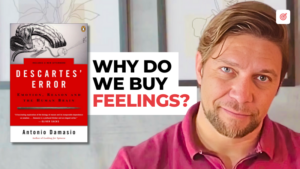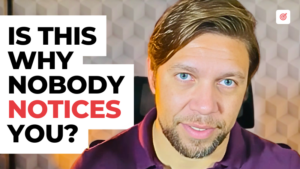
✅ FREE ACCESS: Writing For The Web: How to Keep Fast-Readers Laser-Focused
Can your writing style become a trust magnet? Can the emotional power of your words transform indifference into interest? Is there a way to make logical arguments not only sound smart but also deeply persuasive?
Well, today we’re going to uncover Aristotle’s time-tested trifecta: Ethos, Pathos, and Logos to discover how these ancient yet evergreen concepts can transform your modern Marketing communication into a powerful blend of trust, emotion, and logic.
But before we get into it, make sure you grant your lifetime access to our free WorkBook: Writing For The Web: How to Keep Fast-Readers Laser-Focused.
This is your chance to learn timeless persuasion techniques to attract cost-effective leads and turn them into lifelong customers using only your keyboard powered by AI.
Persuasion: A Journey Through Aristotle’s Marketing Rhetoric
In our digital era, the power of words has never been more critical, and Marketing stands, above all else, as the art of persuasion.
We’re going to dive into practical Marketing applications based on Aristotle’s ‘Rhetoric’, a seminal work in persuasive communication.
To do that, we will divide our approach into the 3 Rhetoric concepts:
- Ethos: Building Trust and Credibility.
- Pathos: Engaging Emotionally.
- Logos: Logical and Persuasive Arguments.
Whether for advertising, social media, blogs, or marketing emails, ethos, pathos, and logos remain fundamental for persuasive Marketing in the modern era.
Ethos: How to Build Trust and Credibility in Modern Marketing
The first of the 3 Aristotle’s Rhetoric principles we’re going to approach is Ethos: How to Build Trust and Credibility in Marketing.
In the book Winning the Story Wars, Jonah Sachs states that:
“Your brand is a story unfolding across all customer touchpoints.”
Ethos, in the context of Marketing, is about establishing your credibility and trustworthiness.
You do that by telling a story grounded on:
- Authority.
- Trustworthiness.
- Consistency.
But how can you build that using Ethos?
How to Build Authority, Trustworthiness, and Consistency
First of all, be transparent and open about your products or services, including any limitations or conditions.
Cite experts in your communication and align your message with trusted sources.
But the most important aspect to build trust, in my estimation, is to keep a consistent tone and message across different mediums.
This approach ensures that your audience receives a uniform experience, no matter how they interact with you or your brand.
Here’s an example of a Marketing campaign.
Pay attention to how the Marketing communication changes from one medium to another while we keep the core message intact.
For your website, you want a more branded communication, like:
“Experience the Future with Our Eco-Friendly Innovations – Pioneering Sustainable Living for a Better Tomorrow.”
For your Email Marketing Campaign, you want to add a subtle urgency, like:
“Join Our Eco-Revolution Today and Lead the Way in Sustainable Living.”
For your Social Media Post, you want to be Concise and Engaging at the same time. You could say:
”Go Green, Live Better!”
For your blog post, you want an emotional appeal, like:
“Changing the World, One Eco-Choice at a Time: Your Path to Sustainable Living.”
Why is that a powerful persuasion tool? Because your audience needs to see your message about 5 to 7 times before they decide if they should move forward or not.
If they find a consistent Marketing message across different mediums, that will remind them about your mission and offers consistently.
There’s no purchase without trust.
Pathos: The Art of Emotional Connection in Marketing Rhetoric
The second of 3 Aristotle’s Rhetoric principles we’re going to approach is Pathos: The Art of Emotional Connection in Marketing.
In the book Start with Why, Simon Sinek encapsulates the essence of connecting emotionally with the audience.
He says:
“People don’t buy what you do; they buy why you do it. And what you do simply proves what you believe.”
Think about the last time a story really gripped you. Was it the facts that caught your attention or the way it made you feel?
This is the essence of Pathos in Marketing.
It enables your audience to see themselves in your narrative, whether it’s your brand’s origin story or a customer’s journey.
If Marketing was music, Pathos would be its rhythm.
The WIIFM Principle
To use Pathos in the context of Marketing persuasion, all you need to do is to apply the WIIFM principle.
What’s the WIIFM principle?
That is “What’s In It For Me?” principle.
To effectively persuade, your Marketing message must answer this question to your audience: “What’s In It For Me?”
This principle directs your Marketing communication in the direction of benefits over features.
What’s the big deal?
Well, people don’t care about the features of your products and services. They care about the benefits they take from the features of your products and services.
In other words, they care about how your solution makes them feel, or “What’s In It For Me?”
Focusing on how your solutions make your audience feel by telling them which benefits they will perceive from your solutions, instead of outlining products’ features, will trigger the “What’s In It For Me?” principle.
How to do that? 4 steps:
1) Bullet-point all the features of your products.
2) Switch places with your customers or buyer personas.
3) Rewrite each feature as an advantage for you as a customer.
4) Translate each advantage into a benefit for you as a customer.
All you have to do after that is to write down these benefits everywhere, from product descriptions to social posts.
Here are a few examples:
Example 1: Customer-Centric Approach
Designed with your needs in mind, our services simplify your daily tasks, letting you focus on what truly matters.
Example 2: Customer-Success Approach
Our product empowers you to achieve more every day.
By integrating Ethos in your Marketing Rhetoric, you build a lasting relationship with your audience based on emotional connections, a powerful and lasting persuasion tool.
In the Writing For The Web Workbook, you will learn timeless persuasion techniques to write effective Marketing messages that attract, engage, and convert cost-effective leads into lifelong customers using only your keyboard powered by AI.
By granting your FREE lifetime access to this workbook today, you will not only master the art of persuasion today but also, have access to all future updates at no cost.
The link is in the description.
Logos: The Art of Rational Appeal in Marketing Rhetoric
The last of the 3 Aristotle’s Rhetoric principles we’re going to approach is Logos: The Art of Rational Appeal in Marketing.
Logos is the aspect of Marketing that appeals to the audience’s rational side, inviting them to see the sense and soundness in your message.
It uses facts, statistics, logical arguments, and clear reasoning to make your point.
This approach is effective in scenarios where decisions are made based on evidence.
Let’s explore how you can practically apply the principle of Logos in various Marketing contexts.
Example 1: Clarity in Service Descriptions
Our streamlined accounting services reduce your paperwork by 50%, giving you more time to focus on growing your business.
Example 2: Comparative Analysis
Our energy-efficient appliances save up to 30% more electricity compared to standard models, offering both environmental and economic benefits.
Example 3: FAQ Sections for Clarity
A sales page needs to include an FAQ section that addresses common customer queries with clear and concise answers.
Here is a way to make your FAQ stand out from all the others:
Instead of adding different questions with long boring explanations, simply write this as the heading of the FAQ section:
The answer for all the questions below is a loud “YES”.
Then, all you have to do is to write short questions as bullet points, like:
Do you provide a 7-day money-back guarantee?
Does the delivery take only 3 days?
Do you provide 24/7 support?
The audience will mentally answer “yes” to all these questions, making it fast and easy to consume it, increasing conversion through logical reasoning.
In essence, Logos in Marketing is about making your message as clear and understandable as possible with the least amount of energy invested.
By applying Logos to your Marketing Rheotoric, you provide your audience with the rationale they need to make informed decisions.
And informed decisions are the ones your customers won’t regret after purchasing from you.




